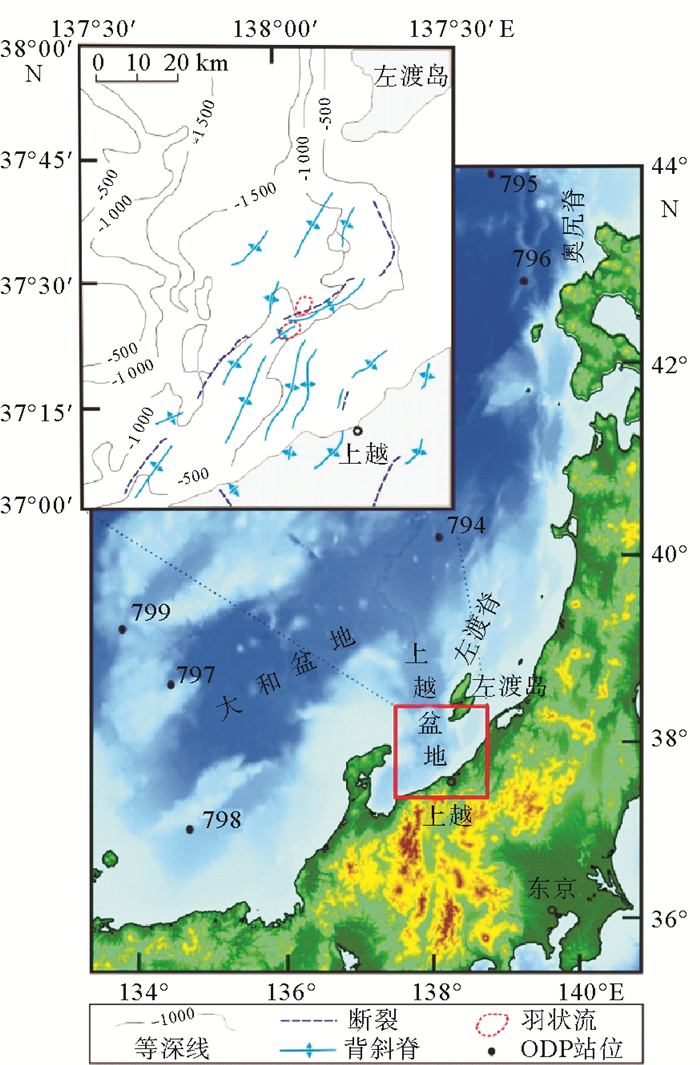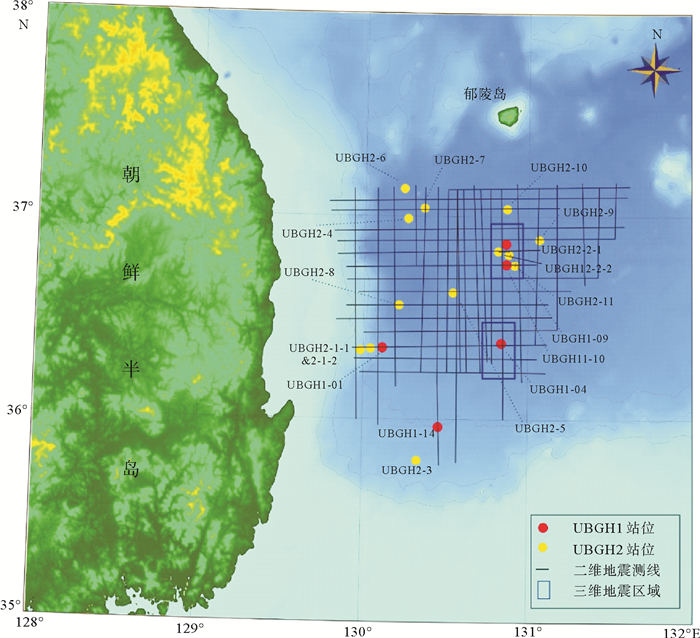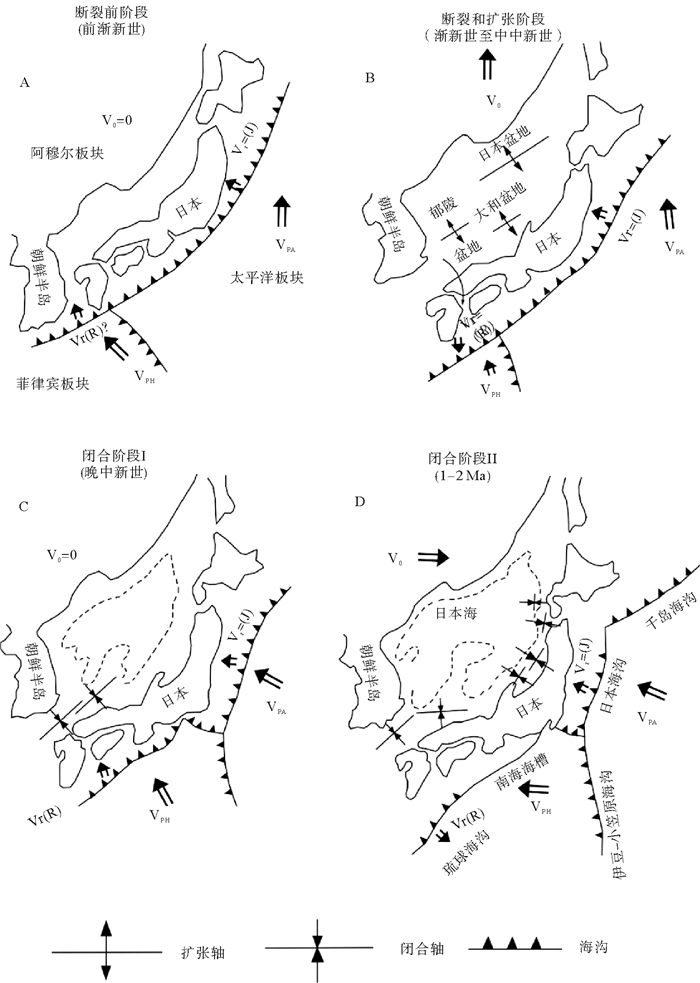DISCUSSION ON GAS ORIGINS AND MAIN CONTROLLING FACTORS FOR GAS HYDRATES IN THE SEA OF JAPAN
-
摘要: 为了探讨日本海天然气水合物的气源成因及其控制因素, 收集和整理了日本海西南郁陵盆地和日本海东缘上越盆地及邻近的相关资料。结果显示,上越盆地及邻近海域甲烷羽状流、麻坑、自生碳酸盐岩及地震剖面上“气烟囱”和BSR等发育,块状水合物出露海底为热解成因;郁陵盆地羽状流不太发育,而自生碳酸盐岩和地震剖面上的“气烟囱”较发育,钻孔发现的水合物主要为生物成因。结合日本海构造演化特征综合分析认为,日本海东缘热解成因水合物的主控因素是近S—N向和近E—W向交互断裂作用以及NE—SW向的晚期构造挤压;日本海西南海域生物成因为主兼热解成因水合物的主控因素是NEE—SWW向的晚期构造挤压;而日本海西北海域构造定型早且缺少晚期构造挤压,因此,推测其水合物气源应该主要为生物成因,热成因的可能性很小。Abstract: In order to understand the gas origins and controlling factors for the gas hydrate in the Sea of Japan, data from both the Ulleung and Joetsu Basins are collected and studied. It is found that methane plumes, pockmarks, authigenic carbonates, gas chimneys, BSR and massive hydrate outcrops are quite popular in the Joetsu Basin of northeast Japan Islands, indicating a thermogenic gas origin. However, in the Ulleung Basin, methane plumes are rare, but rich in authigenic carbonates and gas chimneys, and the gas hydrates encountered so far by drilling wells are biogenic. Integrated with the tectonic evolution of the Sea of Japan, it is concluded that thermogenic gas hydrates occurred on the eastern margin of the sea of Japan are mainly controlled by the interaction of the near S—N faults and the near E—W faults, and the later tectonic compression derived by the activity of the faults in NNE—SSW direction. The biogenic gas hydrates with a few thermogenic gas hydrates on the southwestern margin of the Sea of Japan are mainly controlled by the late tectonic compression with a direction of NEE—SWW. Biogenic gas hydrates may dominate the northwestern margin since it was formed earlier and lack of late tectonic compression.
-
Keywords:
- gas origins /
- main controlling factors /
- interaction Faults /
- the Ulleung Basin /
- the Joetsu Basin /
- Sea of Japan
-
河口海岸地区悬浮物浓度(SSC)及其控制因素研究不仅有助于理解河口海岸带生态过程,也对沉积物侵蚀再悬浮、沉积、地貌演变与海岸工程具有借鉴与指导意义[1]。黄河水下三角洲又因受黄河大量输沙影响,以高悬浮物浓度闻名于世,其悬浮物浓度变化研究备受关注。
近年来,形成了一系列针对水体悬浮物浓度的研究方法。利用数值模拟方法,可以突破悬浮物浓度研究的时空限制[2],但其参数取值受人为因素影响较大。利用卫星遥感数据可以进行大范围水体悬浮物浓度估算[3],但易受天气、海况、时间等因素影响,对一定水深的悬浮物浓度估算能力有限。借助科考船可以分析不同站位悬浮物浓度差异,进行悬浮物浓度剖面分析[4,5],但受船时影响,无法进行长时间连续测量,并且为避免仪器触底,通常不能测量近海床悬浮物浓度。也有学者将遥感数据与船载观测数据联合分析,分析悬浮物浓度分布与季节变化[6,7],但仍无法对近海床的悬浮物浓度进行详细研究。针对近海底悬浮物浓度研究,座底式原位观测装置的应用不失为一种行之有效的研究方法。
原位观测技术在国内的发展,为我国海域悬浮物浓度研究提供了一种有效的观测方法,实现了近海底水体的连续观测[8]。李博闻等[9]在黄河口潮滩进行了为期9天的原位观测;Yang等[10]在胶州湾潮滩地区进行了为期7天的观测;马小川等[11]在北部湾进行了为期约5个月的观测;Zhu等在辽宁白沙湾[12]、渤海浅海区[13]进行了海底原位观测,Liu等[14]在胶州湾进行了海底原位观测;徐景平等在南海深海区也进行了相关原位观测。
针对黄河水下三角洲的原位长期观测工作目前开展较少,本文利用黄河水下三角洲134天的原位观测数据,分析了波浪、海流对悬浮物浓度的影响,得出了该海域悬浮物浓度的叠加锯齿模型。
1. 研究区域与观测过程
1.1 研究区域
本文海底原位观测三脚架站位(38.17°N、118.92°E)所在位置及水深如图 1所示。该站位地处埕岛海域,水深约为6.8m,地势大致东北高西南低。海底原位观测三脚架所处地势相对较高,其北侧约50m位置处存在海底洼地,水深约为12m。海底原位三脚架附近300m范围内没有海底电缆和管道分布。根据现场钻孔资料,该站位表层约5米范围内其沉积物均为黄褐色粉砂,平均含水量为21.54%,平均密度为2.01g/cm3,平均孔隙比为0.64,塑性指数为6.0,液性指数为0.23,沉积物呈硬塑状态。
1.2 观测仪器与观测过程
此次黄河水下三角洲原位观测利用自主研发的海底原位三脚架作为观测仪器搭载平台(图 2)。该海底原位观测三脚架采用不锈钢制作,整体垂直高度为1米,观测仪器安装于搭载横梁之上。搭载仪器主要包括波潮仪(加拿大RBR virtuoso,周期1小时,频率2Hz)、电磁海流计(日本COMPACT-EM,周期30分钟,频率1Hz)、温盐深浊度计(加拿大XR-620 CTD+Tu,周期10分钟,频率1Hz)等。其中浊度传感器位于距海床50cm高度处。
海底原位观测三脚架于2014年12月9日布放于既定观测点。观测仪器提前一天设置采集参数,布放当天现场安装。混凝土配重与三脚架相连,防止极端海况下,过强海流将三脚架移位。同时,混凝土配重与浮标\潜标相连,用以标识三脚架布放位置,便于回收。观测仪器布置如图 3所示。混凝土配重优先通过自动脱钩装置自海面释放,以自由下落方式触底;海底原位观测三脚架通过船载起吊装置平稳下落至海底后,由潜水员水下脱钩。海底原位观测三脚架于2015年4月22日成功回收,观测时间134天。
2. 实验与观测结果
观测仪器布放期间,潜水员通过手持式沉积物取样器采集观测点少量表层沉积物与底层水样用于室内分析。据以确定所观测海域的表层沉积物粒度组成,以及悬浮物浓度与所测浊度的对应关系。
2.1 实验结果
粒度是沉积物的最基本物理特征,也是计算切应力的必需条件。根据Shepard提出的沉积物粒度划分方案,绘制观测站位海域表层沉积物的粒度三角图,如图 4所示。图 4显示观测点表层沉积物以粉砂为主,并含少量黏土质粉砂。通过累计曲线分布与差分计算,可确定该站位沉积物中值粒径为0.023mm。
为确定观测点海域悬浮物浓度与浊度之间的对应关系,利用其表层沉积物与底层海水配置一系列不同浊度值悬浮液,通过便携式浊度仪(美国HACH 2100Q,观测仪器布放前以将其与温盐深浊度计所测浊度值进行校正,两者相对误差小于1.8%)测量其浊度,后经抽滤装置(中国GM-0.33A+1L溶剂过滤器)抽滤,分别称量抽滤前后滤膜(50mm×0.45μm)干重,计算悬浮物质量并进而推算悬浮液浓度。为使浊度与悬浮物浓度的对应关系更加准确,实验室所配置悬浮液的浊度范围与原位观测的浊度范围基本保持一致。室内试验结果表明观测点海域水体浊度与悬浮液浓度存在良好的线性对应关系,如图 5。据此可通过原位观测的海水浊度值反演悬浮物浓度。
2.2 观测结果
图 6为2014年12月13—26日为期14天的观测结果。观测结果显示该海域水深范围为5~7m,一天之内存在两次涨退潮过程,该海域为不规则半日潮,涨潮方向为东北方向,退潮方向为西南,这可能与三脚架所处地势有关。另外,随观测时间增加,潮流流向规律性变弱,这可能与传感器漂移有关。
12月15—16日、20—21日、24日出现3次强浪过程,其有效波高接近或超过2米。利用所测海水浊度,经过数据反演推算观测期间水体悬浮物浓度。结果表明强浪期间,悬浮物浓度明显升高,其浓度峰值接近或超过4g/L,其余时间,最低悬浮物浓度仍维持在2g/L左右。距离海底50cm高度处的悬浮物浓度高于该海域常见海洋调查悬浮物浓度。考虑原因可能因为该次观测采用座底式原位观测三脚架,浊度传感器距离海床高度约为50cm,小于海洋调查中的2m。一般而言,悬沙浓度随水深并非线性增加,常呈现指数、对数、抛物线以及L型等分布形态,尽管不同学者提出了不同的分布形式,但大部分都表明悬沙浓度在距海床较近时发生突增,而非线性增加。另外,所测悬浮物浓度偏高也可能与三脚架阻挡浪、流,形成涡旋进而增大起砂能力有关。
流速一天之内存在约4次流速高值与4次流速低值,该观测点流速除与大/小潮期有关外,也受有效波高的影响,这可能与波浪导致的轨迹流速有关;底层海水温度变化范围为0~3℃,12月20日,海水温度明显下降,接近0℃但仍大于海水冰点,这表明观测期间,海水始终未出现结冰现象,从而证明该次观测原位期间不存在海冰阻碍波浪作用的时间段。
3. 讨论
3.1 切应力分析
波高的量纲为L,流速的量纲为LT-1,两者量纲不一致,无法直接对两者进行比较;将两者转化为相对应的切应力后,量纲统一为MT-2L-1。切应力大小可以直接反映波浪、海流对沉积物的启动能力,继而影响悬浮物浓度。故波致切应力、流致切应力可以在一定程度上反映波浪、海流对悬浮物浓度的影响能力。
本文波致切应力τw 计算依据Jonsson等[15]、Dufois等[16]提出的波致切应力公式,详见公式(1);流致切应力τc 依据Hawley[17]提出的流致切应力计算,详见公式(2);临界切应力τcr 依据Miller等[18]提出的临界切应力公式计算,详见公式(3)。
$$ {\tau _w} = \frac{1}{2}\rho f{\;_w}\mu _w^2 $$ (1) $$ {\tau _c} = \rho \mu _s^2 $$ (2) $$ {\tau _{cr}} = {\theta _{cr}}({\rho _s} - \rho )gd $$ (3) 式中,ρ为海水密度,fw为波浪摩阻系数,μw为波浪轨迹流速,μs为海流底床剪切流速(可由据海床50cm处的观测流速值换算得到),θcr为临界Shields数,ρs为沉积物密度,g为重力加速度,d为沉积物粒径。
流致切应力、波致切应力计算结果如图 7所示。强浪经过期间,该海域底床波致切应力可超过3Pa,其余时间段内,波致切应力较小,几乎为0。流致切应力在强浪经过期间,接近1Pa,但仍小于该时间段内的波致切应力;其余时间段内,流致切应力在0~0.5Pa范围内周期性波动,但远大于该时间段内的波致切应力,也大于中值粒径(0.023mm)对应的底床临界切应力0.045Pa。
通过切应力计算分析可知,强浪期间(有效波高大于或接近2m),波致切应力大于流致切应力,波浪对该海域泥沙起动起控制作用,进而显著提高悬浮物浓度。其余时间段内,波浪对悬浮物浓度的影响作用微弱,海流对泥沙起动其控制作用,悬浮物浓度随流速动态波动。
3.2 悬浮物浓度叠加锯齿波模型
通过切应力分析,可以得出有效波高大于或接近2m时,波致切应力超过3Pa,远大于临界切应力,表层沉积物大量悬浮,导致悬浮物浓度急剧增高,如图 6所示。强浪过后,波高迅速恢复至原先较低水平值,而悬浮物浓度并未呈现类似现象,而是在以特定速率缓慢降低,呈锯齿状,该锯齿状受强浪控制。
图 6显示,强浪过后,悬浮物浓度并非以斜线或者类似斜线形式降低,而呈振荡式下降,即大锯齿之上分布有小锯齿。悬浮物浓度下降可以归因于重力作用下悬浮物沉降。波浪无法解释呈现振荡式下降现象,因此时波致切应力接近于0。图 6、图 8显示悬浮物浓度的小锯齿振荡周期与流速波动周期基本一致,即一天之中存在4次明显波动。且流速高时,悬浮物浓度上升,流速低时,悬浮物浓度降低,这与刘潇等[19]的观测趋势一致,但本文悬浮物浓度较高,这可能与悬浮物浓度的垂向分布规律有关,悬浮物浓度近底时通常会突增[20-22]。通过上述计算与切应力分析可以推断,当波高较小时,悬浮物浓度主要受流速控制,这与切应力分析结果基本一致。
据此得出该海域悬浮物浓度呈现叠加锯齿变化模式。强浪作用时,悬浮物浓度因波浪作用形成大锯齿,强浪消失时,悬浮物浓度因海流作用形成小锯齿,且在重力作用下,悬浮物浓度呈现下降趋势,如图 9所示。大锯齿出现频率取决于强浪出现频率,小锯齿出现频率取决于潮汐类型。半日潮海区,悬浮物浓度一天存在4次波动;全日潮海区,悬浮物浓度一天存在两次波动。悬浮物浓度叠加锯齿模型以时间为轴展开,是一种动态变化模型。
4. 结论
(1) 该海域表层沉积物以粉砂为主,悬浮物浓度与海水浊度存在良好的线性关系,底层(距离海床约50cm处)悬浮物浓度在2~4g/L范围内波动。
(2) 切应力计算结果表明有效波高大于或接近2m时,波浪对该海域泥沙起动起控制作用,进而显著提高悬浮物浓度;其余时间段内,海流对泥沙起动起控制作用,悬浮物浓度动态波动。
(3) 该海域悬浮物浓度变化表现为叠加锯齿模式。因波浪作用而形成大锯齿,因海流作用而形成小锯齿。切应力计算结果可以很好地解释悬浮物浓度的叠加锯齿模型。
-
图 2 上越盆地羽状流、ODP站位及NNE向断层和褶皱分布图[7]
Figure 2. Location maps of gas plume sites, ODP drilling sites and faults and folds in NNE direction in Joetsu Basin
图 4 日本海构造演化[21]
Vo-上驮阿穆尔板块运动方向;Vr(J)和Vr(R)-分别为日本和琉球海沟的运动方向;VPA和VPH分别是太平洋和菲律宾板块的俯冲方向;海沟位于上驮板块上;点线代表 2 000 m水深
Figure 4. Tectonic evolution of Sea of Japan
Vo-motion of overriding Amurian plate; Vr(J) and Vr(R)—hinge migrations of Japan and Ryukyu Trenches, respectively; VPA and VPH—vectors of subducting Pacific and Philippine Sea plates, respectively. Dotted line demotes 2 000 m contour line
演化时间 演化特征 5~0 Ma 上新世至更新世 隆起加速,速率>500 m/ma。郁陵盆地南缘逆冲断层和褶皱。水平挤压造成日本海东缘抬升,形成日本奥尻逆冲构造。 10~7(或8) Ma 晚中新世晚期 隆起开始,拉张转变为挤压 12.5~10 Ma 晚中新世早期 缓慢沉降 15~12.5 Ma
23~19 Ma中中新世
早中新世快速沉降,沉降速率>900 m/ma。日本盆地出现洋壳。郁陵盆地和大和盆地地壳减薄。郁陵断裂和对马岛断裂活动。 >23 Ma 晚渐新世 地壳减薄、初始沉降,非海相和火山碎屑岩广泛沉积 -
[1] Matsumoto R, kakuwa Y, Snyder G, et al. Occurrence and origin of thick deposits of massive gas hydrate, eastern margin of the Sea of Japan. pdfs (No. 2019)[C]//9th International Conference on Gas Hydrates. Denver, Colorado USA, 2017.
[2] Oi T, Sato M, Matsumoto R. Types of gas chimney structures in southeastern parts of the Sea of Japan. pdfs (No. 2028)[C]//9th International Conference on Gas Hydrates. Denver, Colorado USA, 2017.
[3] Ohkawa S, Hiruta A, Yanagimoto Y, et al. Characterization of gas chimneys systems in Joetsu Area, eastern margin of the Sea of Japan, using High-Resolution 3-Dimension (HR3D) seismic data. pdfs (No. 1905)[C]//9th International Conference on Gas Hydrates. Denver, Colorado USA, 2017.
[4] Tanahashi M, Morita S, Kyouna S, et al. Physical properties obtained by LWD for thick, massive gas hydrate in the offshore-Joetsu Area, eastern margin of Japan Sea. pdfs (No. 1636)[C]//9th International Conference on Gas Hydrates. Denver, Colorado USA, 2017.
[5] Kakuwa Y, Ohkawa S, Tanahashi M, et al. Occurrence of methane hydrate in Joetsu Area, the eastern margin of Japan Sea. pdfs (No. 1689)[C]//9th International Conference on Gas Hydrates. Denver, Colorado USA, 2017.
[6] Matsumoto R, Freire A F, Satoh M, et al. Shallow gas hydrate accumulation in the eastern margin of Japan Sea: A potential natural gas resources[C]//AAPG International Conference and Exhibition. Cape Town, South Africa: AAPG, 2008.
[7] Hiruta A, Snyder G T, Tomaru H, et al, Geochemical constraints for the formation and dissociation of gas hydrate in an area of high methane flux, eastern margin of the Japan Sea[J]. Earth and Planetary Science Letters, 2009, 279(3-4): 326-339. doi: 10.1016/j.epsl.2009.01.015
[8] Ryu B J, Collett T S, Riedel M, et al. Scientific results of the Second Gas Hydrate Drilling Expedition in the Ulleung Basin (UBGH2)[J]. Marine and Petroleum Geology, 2013, 47: 1-20. doi: 10.1016/j.marpetgeo.2013.07.007
[9] 徐兆凯, 崔镇勇, 林东日, 等.日本海西部大陆坡自生碳酸盐的特征与成因[J].海洋地质与第四纪地质, 2009, 29(2): 41-47. http://www.wanfangdata.com.cn/details/detail.do?_type=perio&id=hydzydsjdz200902006 XU Zhaokai, CUI Zhenyong, LIN Dongri, et al. Character and origin of authigenic carbonates in the western continental slope of the East Japan Sea[J]. Marine Geology and Quaternary Geology, 2009, 29(2): 41-47. http://www.wanfangdata.com.cn/details/detail.do?_type=perio&id=hydzydsjdz200902006
[10] Xu J Y, Ben-Avraham Z, Kelty T, et al. Origin of marginal basins of the NW Pacific and their plate tectonic reconstructions[J]. Earth-Science Reviews, 2014, 130: 154-196. doi: 10.1016/j.earscirev.2013.10.002
[11] Yoo D G, Kang N K, Yi B Y, et al. Occurrence and seismic characteristics of gas hydrate in the Ulleung Basin, East Sea[J]. Marine and Petroleum Geology, 2013, 47: 236-247. doi: 10.1016/j.marpetgeo.2013.07.001
[12] Ryu B J, Riedel M, Kim J H, et al. Gas hydrates in the western deep-water Ulleung Basin, East Sea of Korea[J]. Marine and Petroleum Geology, 2009, 26(8): 1483-1498. doi: 10.1016/j.marpetgeo.2009.02.004
[13] Choi J, Kim J H, Torres M E, et al. Gas origin and migration in the Ulleung Basin, East Sea: results from the Second Ulleung Basin Gas Hydrate Drilling Expedition (UBGH2)[J]. Marine and Petroleum Geology, 2013, 47: 113-124. doi: 10.1016/j.marpetgeo.2013.05.022
[14] Nakajima T, Kakuwa Y, Yasudomi Y, et al. Formation of pockmarks and submarine canyons associated with dissociation of gas hydrates on the Joetsu Knoll, eastern margin of the Sea of Japan[J]. Journal of Asian Earth Sciences, 2014, 90: 228-242. doi: 10.1016/j.jseaes.2013.10.011
[15] Park K P, Bahk J J, Kwon Y, et al. Korean national program expedition confirms rich gas hydrate deposit in the Ulleung Basin, East Sea[J]. Fire in the Ice: Methane Hydrate Newsletter, 2008, 8(2): 6-9. http://cn.bing.com/academic/profile?id=2f11bb335607c7c700fbb453fcb90908&encoded=0&v=paper_preview&mkt=zh-cn
[16] Bahk J J, Kim G Y, Chun J H, et al. Characterization of gas hydrate reservoirs by integration of core and log data in the Ulleung Basin, East Sea[J]. Marine and Petroleum Geology, 2013, 47: 30-42. doi: 10.1016/j.marpetgeo.2013.05.007
[17] Shimazu M, Yoo S, Tateishi M. Tectonics and volcanism in the Sado-Pohang Belt from 20 to 14 Ma and opening of the Yamato Basin of the Japan Sea[J]. Tectonophysics, 1990, 181(1-4): 321-330. doi: 10.1016/0040-1951(90)90025-4
[18] Jolivet L, Tamaki K. Neogene Kinematics in the Japan Sea Region and Volcanic Activity of the Northeast Japan arc[M]//Tamaki K, Suyehiro K, Allan J, et al. Proceedings of the Ocean Drilling Program, Scientific Results, 127/128, Part 2. College Station, TX: Ocean Drilling Program, 1992: 1311-1331.
[19] Okamura Y. Fault-related folds and an imbricate thrust system on the northwestern margin of the northern Fossa Magna region, central Japan[J]. Island Arc, 2003, 12(1): 61-73. doi: 10.1046/j.1440-1738.2003.00379.x
[20] 金性春.大洋钻探与西太平洋构造[J].地球科学进展, 1995, 10(3): 234-239. http://www.wanfangdata.com.cn/details/detail.do?_type=perio&id=QK199500054160 JIN Xingchun. Ocean drilling program and tectonics of the western Pacific Region[J]. Advances in Earth Science, 1995, 10(3): 234-239. http://www.wanfangdata.com.cn/details/detail.do?_type=perio&id=QK199500054160
[21] Chough S K, Barg E. Tectonic history of Ulleung basin margin, East Sea (Sea of Japan)[J]. Geology, 1987, 15(1): 45-48. http://cn.bing.com/academic/profile?id=294702328ee4961d4e0fed6cee4d9af9&encoded=0&v=paper_preview&mkt=zh-cn
[22] Kakuwa Y, Nakajima T, Matsumoto R. Submarine landslide identified in MD179 cores, off-Joetsu area, eastern margin of the Sea of Japan[J]. Journal of Asian Earth Sciences, 2014, 90: 218-227. doi: 10.1016/j.jseaes.2013.07.038
[23] Freire A F M, Matsumoto R, Santos L A. Structural-stratigraphic control on the Umitaka Spur gas hydrates of Joetsu Basin in the eastern margin of Japan Sea[J]. Marine and Petroleum Geology, 2011, 28(10): 1967-1978. doi: 10.1016/j.marpetgeo.2010.10.004
[24] Ingle Jr J C, Suyehiro K, von Breymann M T, et al. Proc. ODP. Init. Repts[R]. College Station, TX: Ocean Drilling Program, 1990.
[25] Tamaki K, Suyehiro K, Allan J, et al. Tectonic Synthesis and Implications of Japan Sea ODP Drilling[M]//Tamaki K, Suyehiro K, Suyehiro K, et al. Proceedings of ODP, Scientific Results, 127/128, Part 2. College Station, TX: Ocean Drilling Program, 1992: 1333-1348.
[26] Yoon S H, Sohn Y K, Chough S K. Tectonic, sedimentary, and volcanic evolution of a back-arc basin in the East Sea (Sea of Japan)[J]. Marine Geology, 2014, 352: 70-88. doi: 10.1016/j.margeo.2014.03.004
-
期刊类型引用(4)
1. 黄伟,张伟,梁金强,尚久靖,孟苗苗,单晨晨. 琼东南盆地和郁陵盆地天然气水合物成藏对比研究. 中国矿业大学学报. 2021(02): 363-380 .  百度学术
百度学术
2. 张伯达,雷振宇,郑文义,李政坤,蔡达仰,张金锋,苏明,杨睿. 地震资料中柱状流体运移通道形态参数及其地质意义. 海洋地质与第四纪地质. 2019(03): 171-181 .  本站查看
本站查看
3. 付志方,孙自明,高君,滕彬彬. 西非下刚果盆地海底麻坑特征及与盐岩活动的关系. 海洋地质与第四纪地质. 2018(04): 164-169 .  本站查看
本站查看
4. 魏伟,张金华,于荣泽,林斌斌,陈龙桥,彭涌,肖红平. 2017年天然气水合物研发热点回眸. 科技导报. 2018(01): 83-90 .  百度学术
百度学术
其他类型引用(1)




 下载:
下载:












